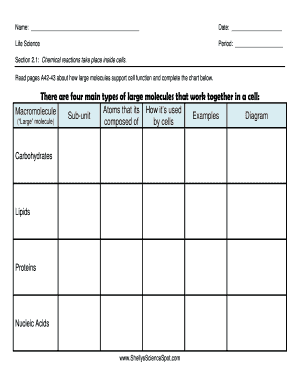
Macromolecules Chart Form


What is the Macromolecules Chart
The macromolecules chart is a visual representation that categorizes and describes the four primary types of macromolecules: carbohydrates, lipids, proteins, and nucleic acids. Each category plays a crucial role in biological processes and structures. This chart serves as an educational tool, helping students and professionals understand the functions, structures, and examples of each type. By providing a clear overview, it supports learning in fields such as biology, biochemistry, and health sciences.
How to Use the Macromolecules Chart
Utilizing the macromolecules chart involves referencing it to identify the characteristics and functions of each macromolecule type. Users can fill out the chart by noting specific examples, such as glucose for carbohydrates or enzymes for proteins. This process aids in reinforcing knowledge and can be particularly beneficial during study sessions or while preparing for exams. Additionally, the chart can be used in research settings to quickly reference macromolecule types and their roles in various biological systems.
Steps to Complete the Macromolecules Chart
Completing the macromolecules chart requires a systematic approach. First, gather relevant information on each macromolecule type. Next, identify key features such as structure, function, and examples. Fill in the chart by categorizing each macromolecule appropriately. Ensure that all sections are filled out to provide a comprehensive overview. Reviewing the completed chart can enhance understanding and retention of the material.
Legal Use of the Macromolecules Chart
The legal use of the macromolecules chart pertains to its application in educational and research contexts. It is essential to ensure that any use of the chart complies with copyright regulations, especially if sourced from published materials. When distributing or displaying the chart, proper attribution should be given to the original creators. This practice not only adheres to legal standards but also promotes academic integrity.
Key Elements of the Macromolecules Chart
Key elements of the macromolecules chart include the four types of macromolecules, their respective structures, and functions. Each section typically outlines specific examples, such as starch for carbohydrates or DNA for nucleic acids. Additional details may include the building blocks of each macromolecule, such as monosaccharides for carbohydrates and amino acids for proteins. Understanding these elements is vital for grasping the complexity of biological systems.
Examples of Using the Macromolecules Chart
Examples of using the macromolecules chart can be found in various educational scenarios. In a classroom setting, teachers may use the chart to facilitate discussions on cellular functions. Students might refer to the chart while preparing for biology exams or completing assignments. Additionally, researchers may utilize the chart as a quick reference guide when examining the roles of macromolecules in experimental studies or publications.
Quick guide on how to complete carbohydrates lipids proteins and nucleic acids chart
Complete carbohydrates lipids proteins and nucleic acids chart seamlessly on any device
Online document management has become increasingly favored among businesses and individuals. It offers an ideal eco-friendly substitute for conventional printed and signed papers, allowing you to access the correct form and securely store it online. airSlate SignNow equips you with all the tools necessary to create, modify, and electronically sign your documents swiftly without delays. Handle macromolecules chart blank on any platform with airSlate SignNow’s Android or iOS applications and simplify any document-related process today.
How to modify and electronically sign macromolecules chart pdf effortlessly
- Locate 4 types of macromolecules chart and then click Get Form to commence.
- Utilize the tools we provide to fill out your form.
- Emphasize relevant sections of your documents or obscure sensitive information with tools that airSlate SignNow offers specifically for that purpose.
- Create your signature using the Sign tool, which takes mere seconds and holds the same legal validity as a conventional wet ink signature.
- Review the information and then click on the Done button to save your changes.
- Choose how you would like to send your form, whether by email, text message (SMS), invite link, or download it to your computer.
Eliminate concerns about lost or misfiled documents, tedious form searching, or mistakes that necessitate printing new document copies. airSlate SignNow fulfills your document management needs in just a few clicks from any device of your choice. Alter and electronically sign macromolecules chart and ensure outstanding communication at every stage of the form preparation process with airSlate SignNow.
Create this form in 5 minutes or less
Related searches to macromolecules chart blank
Create this form in 5 minutes!
How to create an eSignature for the macromolecules chart pdf
How to create an electronic signature for a PDF online
How to create an electronic signature for a PDF in Google Chrome
How to create an e-signature for signing PDFs in Gmail
How to create an e-signature right from your smartphone
How to create an e-signature for a PDF on iOS
How to create an e-signature for a PDF on Android
People also ask macromolecules chart
-
What is a macromolecules chart blank?
A macromolecules chart blank is a customizable resource that allows users to fill in details about the major biological macromolecules, such as carbohydrates, proteins, lipids, and nucleic acids. This tool is especially useful for educators and students looking to understand these complex molecules in depth. By providing a visual representation, it aids in both teaching and learning.
-
How can I use a macromolecules chart blank in my classroom?
You can utilize a macromolecules chart blank as a teaching aid in biology classes to enhance student engagement. By having students fill out the chart during lessons, they can actively learn and visualize the relationships between different macromolecules. It serves as a great homework assignment or group activity as well.
-
Are there different versions of the macromolecules chart blank available?
Yes, there are various versions of the macromolecules chart blank available, including those tailored for different age groups and educational levels. Some may include additional information or diagrams to cater to advanced students. You can find printable templates and digital versions online for easy access.
-
Is the macromolecules chart blank available for free?
Many educational resources offer a macromolecules chart blank for free, especially those aimed at enhancing learning in classrooms. Additionally, some platforms may provide premium versions with added features or customization options for a fee. It's worth exploring multiple sources to find the best chart format that suits your needs.
-
What features should I look for in a macromolecules chart blank?
When choosing a macromolecules chart blank, look for clarity in labeling, space for detailed notes, and the inclusion of diagrams if applicable. A user-friendly format can signNowly enhance comprehension, allowing students to visualize the structure and function of various macromolecules. Additionally, consider if it's easily accessible in a digital format.
-
Can I integrate a macromolecules chart blank into my existing curriculum?
Absolutely! A macromolecules chart blank can be easily integrated into your existing curriculum as a supplementary resource. It complements standard biology lessons or lab work effectively, enhancing students' understanding of the biochemical foundations of life.
-
What are the benefits of using a macromolecules chart blank?
Using a macromolecules chart blank helps students organize and retain information about biological macromolecules efficiently. This visual aid can enhance their overall understanding and retention of complex concepts. It fosters an interactive learning environment that engages students actively.
Get more for carbohydrates lipids proteins and nucleic acids chart
Find out other macromolecule chart answer key
- Electronic signature Washington Standstill Agreement Safe
- Electronic signature New Hampshire Customer Confidentiality Agreement Myself
- Electronic signature New Hampshire Customer Confidentiality Agreement Free
- How Can I Electronic signature Nevada Customer Confidentiality Agreement
- Electronic signature New Hampshire Customer Confidentiality Agreement Secure
- Electronic signature New Hampshire Customer Confidentiality Agreement Fast
- Electronic signature New Hampshire Customer Confidentiality Agreement Simple
- Electronic signature New Hampshire Customer Confidentiality Agreement Easy
- Can I Electronic signature Nevada Customer Confidentiality Agreement
- Electronic signature New Hampshire Customer Confidentiality Agreement Safe
- How To Electronic signature New Hampshire Customer Confidentiality Agreement
- How Do I Electronic signature New Hampshire Customer Confidentiality Agreement
- eSignature Arizona Employee Appraisal Form Online
- Help Me With Electronic signature New Hampshire Customer Confidentiality Agreement
- Electronic signature New Jersey Customer Confidentiality Agreement Online
- How Can I Electronic signature New Hampshire Customer Confidentiality Agreement
- Can I Electronic signature New Hampshire Customer Confidentiality Agreement
- eSignature Arizona Employee Appraisal Form Computer
- Electronic signature New Jersey Customer Confidentiality Agreement Computer
- How To eSignature Arizona Employee Appraisal Form